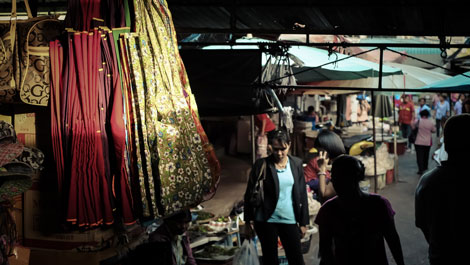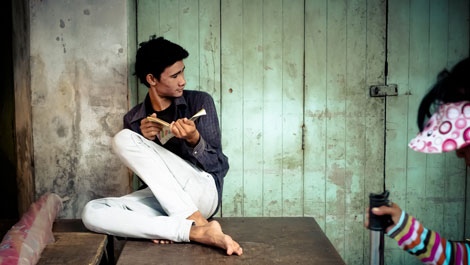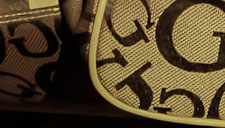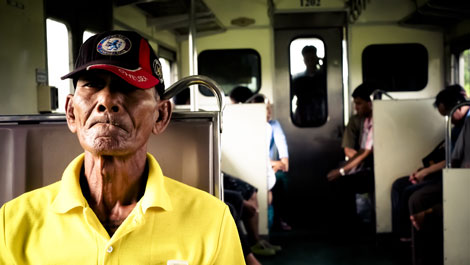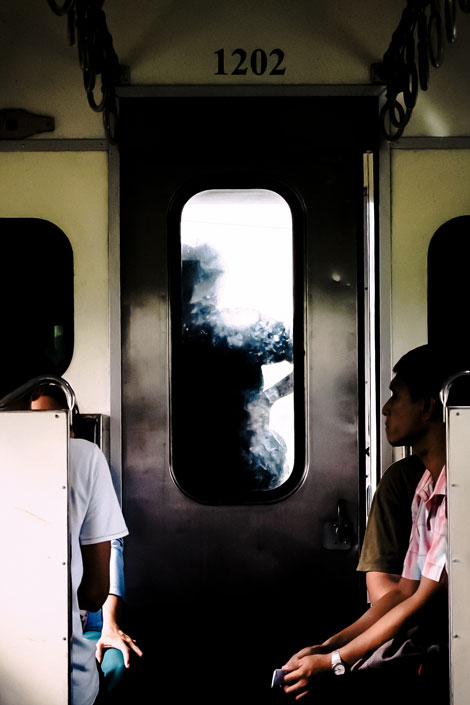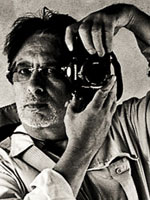
The Fujifilm X-Pro1 a rangefinder? The question is moot. While Fujifilm does have a history of rangefinder cameras reaching back to the early 1970s, one has to ask what defines a camera as being a rangefinder. While there is for example no mirror-slap in the Fujifilm X-Pro1 we will not find what for many defines the rangefinder: the double image to be superimposed within the viewfinder itself.
+++ Order the Fujifilm X-Pro1 from Amazon, B&H or Adorama. BTW, Adorama has a special bundle with all three lenses. +++
The viewfinder is big and depending on how we use it we can, in theory, get more into the picture than meets the eye. Really I should say more than what will be in the image itself. We can see more than what will be in the final image itself. It depends on which optical magnifier you choose.
I personally had some trouble in this regard with the optical viewfinder and occasionally ended up with edges of heads cut off. While I am sure someone more persevering will figure this out easily enough. After only a few days with the X-Pro1 though I found myself fidgeting.
The viewfinder also hosts 40 selectable AF points. I have always found this an oddity but in today’s world where photographers rely on the electrical capabilities of their cameras this high number will satisfy most needs.
There are also ten film simulation modes available. Needless to say I did not need or even try these. I will take my photographs in normal mode and, if so desired, do a basic amount of changes in Lightroom and/or Photoshop. Explore and have fun otherwise.
As one of the attractive elements of this camera is its simple design and ease of use, this is what I was looking for shooting this little review. Overall, it did not disappoint.
It should be pointed out the viewfinder was very bright, large and easy on the eyes. Again, it does not have the nifty and helpful viewfinder patch many have come to appreciate so much and rely on. The frame-lines though tended to be somewhat off at times.
It has sometimes been suggested rangefinder will not show in the viewfinder what we will end up with on the negative. I have found experience and practice will do just fine.
As for the rest of the camera it must be said it does not only resemble a rangefinder but in some ways acts like one too.
One big advantage is the nature of the camera when in use. Fewer people will be intimidated by this camera than the often huge SLR cameras being pointed at people today like little canons, oops, cannons. It is not tiny, but it is not intrusive.
Some have said the actual shutter is as silent as a Leica. This is not true. The Leica shutter is still, IMO, possibly the quietest of all shutters. I was actually left feeling a bit quizzical about the shutter noise. But I do believe that was more due to expectations than being overwhelmed.
This Fujifilm does resemble a rangefinder to the point one can expect it do actually be more of one.
I did find myself using the camera more like one of my rangefinders than had I had an SLR in my hands. I felt better, more a part of my surroundings and less noticeable. After having tested the Canon 5D Mark III it was like taking a weight off one’s shoulders; both figuratively and literally. The Fujifilm actually feels like a rangefinder, both in the hand and in use. The Fujifilm actually feels like a rangefinder even in use.
One dislike I had was the grip. Let me say I once bought a grip for my Leica MP and used for possibly three weeks, trying my best to get used to it. In the end it was left in its box. I much prefer shooting without the grip. This is certainly a question of personal taste. But having the choice of a grip or not is better.
The exposure worked very well. I used aperture priority almost exclusively and beside a few very low light situations it seemed to be spot on.
The word on the street is the exposure and AF do not work well in low light. While there were a few moments I felt annoyed I am sure in general it actually worked very well.
As for the other word on the street the Fujifilm cannot handle high ASA in low light I found this to be completely the opposite. At ISO 3,200 the camera churned out very clear images indeed. I doubt any but the best of the high-end SLR cameras around could match this. While sharpness is not a be all and end all for me I was impressed nonetheless.
Let it be said when I shoot film, which is what I mostly do, and I choose ASA 1,600 or 3,200 — I am doing so for the effect. With digital, ISO is often seen as simply a device to allow sharpness at low light levels and thereby capture otherwise lost images. Grain and bokeh and noise are not the same thing.
Being Fujifilm’s first interchangeable lens camera since its FinePix S5 Pro I would say Fujifilm wanted to make sure whatever it came up with was a success. IMO it has done an excellent job. Although it is an APS-C sized sensor (X-Trans CMOS) it has somehow cleverly managed to bring up to par with full-frame cameras. The quality of the image @ 16MP is striking. This camera has no anti-aliasing filter which leads to producing sharper images.
Fujifilm has introduced three compatible XF lenses; the Fujinon 18mm F2, 35mm F1.4 and 60mm F2.4 Macro, these have a focal length equivalent to 27mm, 53mm and 91mm optics on a full-frame camera.
All image samples in this series are shot with the 35mm F1.4.
The lenses which coincide with the release of the X-Pro1 have aperture rings for adjusting exposure via f-stops in increments of thirds. The setting of aperture in increments of thirds is easy, possibly a bit too easy. I prefer lenses where the setting will be just a tad tougher but, in truth I had no problem with this.
Once attached these lenses show to be of a very high quality, and fast enough for just about anyone’s use.
One quirk some digital photographers may be annoyed by is the absence of an immediate instant review histogram option. By that I mean there us no histogram — or I thought so. In order to view a history you must stop your shooting and go into the playback mode. Actually — you can get a live histogram in both OVF and EVF mode. But Fujifilm being Fujifilm its not intuitive to turn it on.
Another negative word in the street is the next to useless auto ISO. I found this too to be incorrect and have been pleased with the results. That could reflect to some extent on the subjects I shoot, meaning people and people in places, like streets, markets, train stations, etceteras.
I am not sure if the recent firmware update has addressed this issue but again for street and travel photography it should not be an issue. People have become a bit too spoiled and rely on the camera’s auto functions instead of taking control themselves. Getting back to the roots, the basic essentials must be a good thing.
In summary while not perfect and not exactly everything a film rangefinder user would hope for from a digital camera, this little Fujifilm X-Pro1 does a very good job at fooling whoever has his or her finger on the shutter into believing this is about as close as we can get to the original experience without actually using film.
Remember this camera is about 25-30% of the price of a Leica M9. And because digital photography is so reliant on post-processing anyway, I find it difficult to understand why anyone would, unless independently wealthy, seriously consider buying an M9 instead.
And then there are the lenses to consider. But that is another kettle of fish. The pros and cons of Leica lenses versus any other can not be taken up within the framework of a short, film-shooting photographer’s review of the Fujifilm X-Pro1.
Still, is this the poor man’s Leica?
That’s the rhetorical buzz on the street right now.
I could get an excellent Leica M2 or M3 and a decent 50mm lens for a far lower price. Remember the 35mm on the Fujifilm is really a 53mm full-frame.
If referring to the digital M9 yes of course the statement is very true and IMO the M9 is nothing to write home about.
I recently posted an image on Facebook which received well over 60 likes in the black-and-white world group. It also received about 30 in another until I accidentally deleted it. I have never received so many likes on Facebook. On Flickr yes, a dozen around 100; but not in three or four days.
That image was taken with a borrowed camera phone and worked on a bit in Lightroom.
This is further proof for me digital images are made or killed in post-processing. Most digital images straight out of the camera need some kind of post-processing to get punch.
Again IMO there is little valid reason for 99% of people to choose the M9 over the new Fujifilm. I would not hesitate and get the X-Pro1.
Verdict
While not cheap, neither is the X-Pro1 expensive. The feel-good factor is undeniably there. The few quirks one needs to deal with can probably be dealt with and adapted too within a couple of weeks.
Personally the images I have made with this camera impress me. I would say, without mentioning any other makes or models, considering the size and ease of use, the quality of images is definitely not below those of bigger, less easily handled SLRs for which we pay a heck of a lot more.
I could even risk saying the images are better but am fully aware using a camera that feels right will make more successful images than one that does not feel quite right in the hands.
Compared to the previous Fujifilm X100 which seemed to appeal to some extent to vanity and the “I gotta have one of them there RF looking camers” knee-jerk reaction, this is a camera which will justify its investment and keep the shooter happy for a long time.
+++ Further below’s the rest of the X-Pro1’s yield — or see the larger resolution gallery. And thanks for the loaner John!
And don’t forget to tune in to our continuously updated The Fujifilm X-Pro1 Review File.
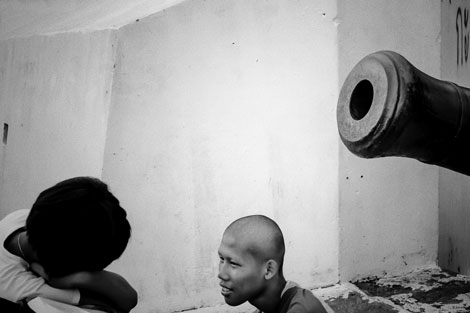
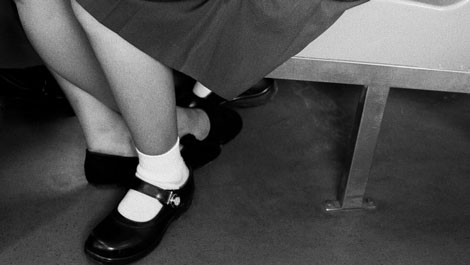
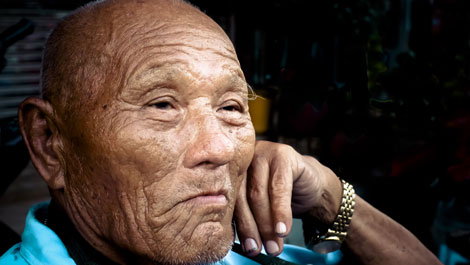
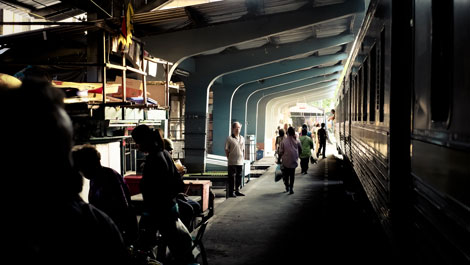
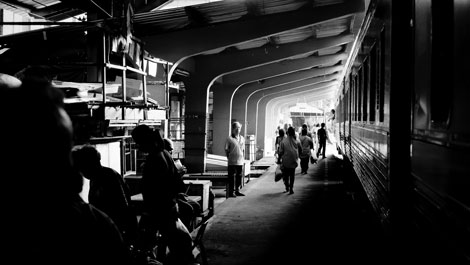
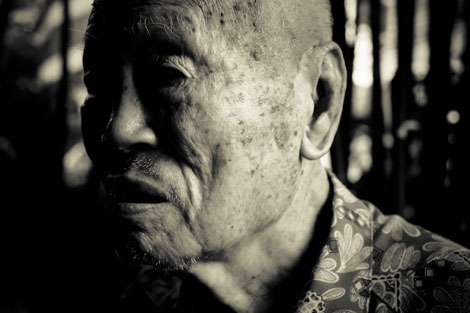
+++ Order the Fujifilm X-Pro1 now from Amazon, B&H or Adorama. BTW, Adorama has a special bundle with all three lenses! +++



